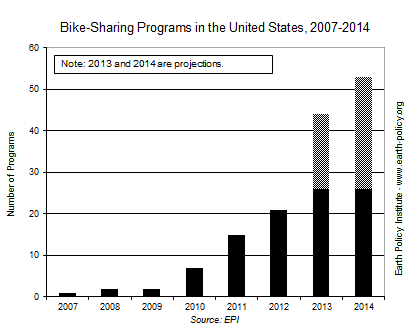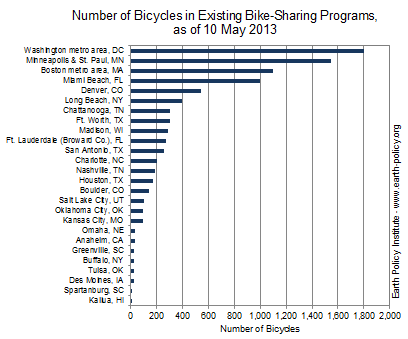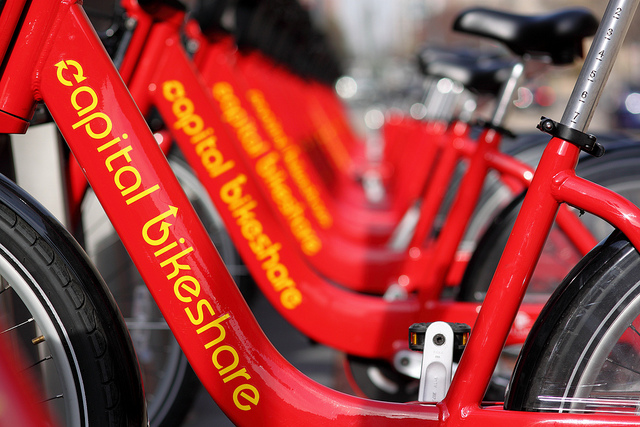When New York City opened registration for its much anticipated public bike-sharing program on April 15, 2013, more than 5,000 people signed up within 30 hours. Eager for access to a fleet of thousands of bicycles, they became Citi Bike members weeks before bikes were expected to be available. Such pent-up demand for more cycling options is on display in cities across the United States - from Buffalo to Boulder, Omaha to Oklahoma City, and Long Beach in New York to Long Beach in California - where shared bicycle programs are taking root.
At the start of 2013, the United States was home to 22 modern public bike-sharing programs. By spring 2014, that number will likely double as a flurry of cities joins the more than 500 bike-sharing communities worldwide. (Read more about bike sharing around the globe here.) With the expansions of current programs and new openings in larger markets like New York City, Chicago, Los Angeles, and San Francisco, the nationwide fleet of shared bikes is poised to quadruple in the next couple of years, from nearly 9,000 to above 36,000. And with a growing list of American communities exploring the possibility of setting up bike shares, this number is expected to continue to climb.
 Bike-Sharing Programs in the United States, 2007-2014.
Bike-Sharing Programs in the United States, 2007-2014.
People are fond of quipping that nothing good comes out of Washington, but many of the American cities launching bike-sharing programs got turned on to the idea of bikes-as-transit by watching the nation's capital. Capital Bikeshare began operation in September of 2010, replacing a smaller short-lived program that started in 2008 but was never expansive enough to be successful. (In 2007, Tulsa, Oklahoma, was actually first in the country to open an automated bike-share system, with a couple dozen bikes at three solar-powered stations.) During its reign as the largest bike-sharing program in the United States, Capital Bikeshare has been enormously popular among residents and visitors alike, who together have logged more than 4 million rides. Now with more than 1,800 bright red bicycles stationed at 200 locking docks within DC and the northern Virginia communities of Arlington and Alexandria, Capital Bikeshare soon will expand into neighboring Montgomery County, Maryland. The total fleet is expected to reach 3,700 bikes at more than 300 stations by the end of 2013.
As in many of the programs, people can sign up for a short-term or an annual membership with a credit card online or in person at a station kiosk. They then can unlock a bicycle and return it to any station within the system. All rides under 30 minutes are free, after which escalating fees kick in, encouraging people to make short trips and to keep more bikes available for other riders.
After test runs of bike sharing with temporary programs installed for the 2008 national presidential nominating conventions, nonprofit organizations in the Twin Cities and in Denver opened programs in 2010. Nice Ride Minnesota covers Minneapolis and St. Paul with 1,550 bikes at 170 stations. Among the nearly 60,000 users in 2012 were more than 200 employees of the Minneapolis city government, who save the city money when they use the bikes to travel to meetings and make inspections. Nice Ride is one of the seasonal bike shares that closes during the coldest months, even though the area's burgeoning bicycle culture makes it a priority to plow snow from some of the 177 miles of bikeways - a lane-mileage-to-resident ratio that rivals even the bike mecca of Copenhagen. The cycling improvements are paying off: bike commuting in Minneapolis increased from 1.9 percent of trips in 2000 to 3.5 percent in 2011.
Denver's program of 540 bikes at 53 stations is expecting to have at least 700 bikes and 80 stations in 2013. It is part of the B-cycle family of bike shares covering more than 15 locations, including Fort Lauderdale/Broward County in Florida, Nashville, Houston, and Boulder. Members can use their cards to unlock bikes in any of the other public B-cycle programs. At its Madison and San Antonio operations, B-cycle is testing out a utility tricycle, which could appeal to a wider variety of users by providing increased stability and allowing cargo hauling. Charlotte B-cycle showed how quickly a bike share can get off the ground when it opened in 2012, barely a year after the project's conception.
 Number of Bicycles in Existing Bike-Sharing Programs, as of 10 May 2013.
Number of Bicycles in Existing Bike-Sharing Programs, as of 10 May 2013.
Boston started its Hubway bike share to great acclaim in 2011, quickly surpassing ridership projections. The program has since grown from 600 to 1,100 bikes in Boston and neighboring locales. The Boston Public Health Commission provides low-cost annual membership to low-income residents ($5, including a helmet, instead of the regular $85). Another large bike share that opened in 2011 was in Miami Beach. The operator, the private company DecoBike, boasted nearly 1.3 million rides in 2012, making its bikes there the busiest in the country. With a high influx of tourists to this barrier island resort community, more than 300,000 people already use the system each year. The program will soon be expanded to the city of Miami, adding 500 bikes to the current fleet of 1,000.
In the largest of the new wave of 2013 bike-share openings, New York City is poised to roll out some 6,000 bicycles at 330 stations in Manhattan and Brooklyn in late May, with the long-term goals of expanding to other parts of the city and growing to 10,000 bikes. This is one of several new programs to be run by Alta, the same company operating schemes in DC, Boston, and Chattanooga. While New York's launch has been delayed several times, first due to software glitches and then because of damage caused by Hurricane Sandy, it continues an ongoing series of improvements for bikers in a city where fewer than half of residents own cars. Some 300 miles of lanes have been carved out of New York's busy streets as part of Mayor Michael Bloomberg's sustainability strategy for the city. Bike commuting has more than tripled since 2000.
Annual membership in Citi Bike (named this because of its sponsorship by Citibank) costs close to $100 - like so many things in Manhattan, higher than in most other cities - but, as Transportation Commissioner Janette Sadik-Khan points out, this is still less than the price of a monthly subway pass. Members are likely to save money if biking replaces even some bus, subway, and especially taxi journeys. DC bike sharers found that annual membership saved them an average $800 in transportation costs. And bike sharing is far, far cheaper than the $7,800 cost that AAA estimates for the average person to own a car and drive it 10,000 miles a year (depreciation and gasoline expenditures included).
 Current and Future Number of Bicycles in Large Bike-Sharing Programs in the United States.
Current and Future Number of Bicycles in Large Bike-Sharing Programs in the United States.
Bike shares in Chicago and San Francisco will also be operated by Alta. Chicago's program, named Divvy, is planning to have 300 stations docking 3,000 bikes by the end of August 2013, hoping to grow to 400 stations and 4,000 bikes in 2014. Meanwhile the city already claims the most bike parking in the country and is expanding its bikeways to span 645 miles, bringing paths and trails to within a half-mile ride of all residents. Mayor Rahm Emanuel explains that his "vision is to make Chicago the most bike-friendly city in the United States," attracting energetic tech workers from historically bike-friendly areas like Seattle.
An expansive bike share is being planned in the San Francisco Bay Area, where 700 bikes are planned to roll in August. About half will be in San Francisco proper and the rest in cities along the 50 mile transit corridor south to San Jose. Overseen by the regional air quality control agency, the program aims to get more people out of private vehicles in order to cut tailpipe pollution and reduce crowding on public transportation. The Caltrains that run between San Francisco and San Jose already carry over 4,000 bikes each month and end up turning away riders when the special bike cars are full. Bike sharing has the potential to free up some of that space by allowing commuters to pick up a bike on either end of their train ride, addressing what is known as the first- and last-mile problem. The long-term goal is to reach a regional fleet of up to 10,000 shared bikes.
Southern California, with its bike-friendly climate, is also riding in to the bike-sharing game. DecoBike is planning an 1,800-bike system in San Diego. Another firm, Bike Nation, plans to open a program in Long Beach with 250 bikes by year's end. The fleet could grow to 2,500 in the next four to five years, capitalizing on the new bike lanes and separated tracks that have helped biking in Long Beach jump 70 percent over the last 4 years. As more riders have taken to their bikes, both car and bike accidents have fallen precipitously.
Bike Nation is also bringing up to 4,000 bikes to Los Angeles and neighboring communities this year. This sprawling car-centric city has been on a bike improvement crusade since Mayor Antonio Villaraigosa was cut off by a taxi cab while cycling and broke his elbow in 2010. In the years since, the city has installed 123 miles of bike lanes and sponsored several CicLAvia's - one-day events inspired by the ciclovÃas of Bogotá and Mexico City, when selected major streets are closed off to motor vehicles, allowing bikes and pedestrians to take over in a festival-like atmosphere. The April 2013 event attracted an estimated quarter-million people.
Other cities with large public cycling programs on the horizon include Philadelphia, Phoenix, Pittsburgh, and Seattle. (See Table.) Portland, Oregon - America's quintessential bike town, where bikes are given out to low-income residents, bike lanes are ubiquitous, and certain traffic lights are engineered to give priority to cyclists - first got into the sharing game with a "yellow bike" program that started in 1994. Donated bikes were painted bright yellow and scattered around the city for free use. Twenty years later, Portland plans to open a modern bike share with 750 bikes at 75 automatic docking stations. The city hopes that having more bikes readily accessible for spontaneous jaunts could boost cycling even more, from its current 6 percent of trips (already up from 1 percent in 1990).
One of the communities with a smaller program opening in 2013, Hoboken, New Jersey, plans to begin a unique hybrid bike-sharing and bike rental scheme in June, less than two months after achieving unanimous City Council approval. Bike and Roll, which currently rents out 2,000 bikes in New York City - the nation's largest traditional bike rental fleet - will open a pilot scheme in Hoboken with 25 rental bikes for longer-term usage and 25 bike-share bikes for short trips. The goal is to develop a synergy between bicycles and the ferries that efficiently move commuters and tourists between New Jersey and New York.
Hoboken's bike-share bikes are from Social Bicycles (SoBi), one of a few startup companies that have removed the requirements for electronic docking stations by integrating the locking component and GPS tracking into the bicycle itself. While users are still encouraged to leave the bikes at specified hubs, they also can lock them to regular bike racks or other street fixtures, a feature that is common in bike-sharing schemes in Germany, for example, but not so far in the United States. For its first public initiative, SoBi delivered a set of bikes to Buffalo for a venture connected with a car-sharing company. It plans to take this technology to Tampa for a 300-bike system at the end of 2013.
Another smart-lock bike share is scheduled to open later in 2013 as part of a downtown revitalization initiative in Las Vegas. The initial pilot program will involve 50 to 150 high-tech bikes from ViaCycle, which currently operates smart-lock bike shares on the campuses of Georgia Tech and George Mason University, two of the handful of American campuses that have gone beyond traditional bike rentals and bike libraries into the world of modern bike sharing.
Forgoing the electronic docking stations in favor of smart-locking bikes can theoretically drop the pro-rated capital cost of a bike-share bicycle from in the neighborhood of $6,000 to closer to $1,500. Either way, bike shares and bicycling infrastructure give a big bang for the buck. For example, Capital Bikeshare in Washington could double its bikes and docking stations at the same cost of constructing just one mile of one lane of highway. While cars have brought pollution, congestion, and road rage to cities, bicycles can lead to cost savings from improved mobility, reduced wear and tear on roads, and less valuable real estate devoted to parking.
Bike shares can also boost business. Each ride in the Twin Cities' Nice Ride system was found to bring $7-14 to the local economy. Forty-four percent of Capital Bikeshare riders surveyed used bike share to make a trip they otherwise would have skipped, largely for entertainment, socializing, and dining out. A bicycle places people within a city landscape, allowing them to easily make stops, as opposed to merely shuttling through it sequestered inside a private car. Shops and restaurants often report a surge in business after the creation of a bike lane on their street. On a given weekend afternoon in vibrant downtown Long Beach, California, there are often more bikes parked than there are spaces for cars.
Nationwide data from the National Sporting Goods Association indicate that over the last 20 years the number of bikers has fallen from more than 50 million to below 40 million. Yet while there are fewer people who climb on a bicycle in a given year, the number who ride frequently, like for commuting or regular activities, has actually risen over the past decade. Bike sharing can help facilitate this increase and put more folks back on two wheels. The high visibility that comes with a bike-share system reminds people that biking is a viable transit option and encourages more riding overall. In San Antonio and Washington, DC, for instance, retail bike sales have increased since the start of bike sharing.
Furthermore, as cities are improving their cycling infrastructure, the health benefits of the bicycle are becoming more obvious. Studies show that regular utilitarian cycling to get to work can beat out the gym for improving fitness. During the first year that people abandon regular driving to become a bike commuter, they can lose 10 pounds or more. Such health benefits are part of the reason why the health care company Humana houses a bike share for its employees in Louisville and was one of a trio of businesses (along with bicycle manufacturer Trek and advertising firm Crispin Porter + Bogusky) that came together to develop B-cycle. Blue Cross Blue Shield, another health insurer, is a major sponsor for several bike-sharing programs, including those in Charlotte, Houston, Omaha, and the Twin Cities.
The U.S. Conference of Mayors, representing more than 1,300 cities across the country, noted at its 2012 meeting that "communities that have invested in pedestrian and bicycle projects have benefited from improved quality of life, a healthier population, greater local real estate values, more local travel choices, and reduced air pollution." The group passed a resolution "in support of alternative modes of transportation, such as bikesharing programs, as a means to increase transportation mobility and mode choice." Along with these benefits, bike shares can bring the freedom, convenience, and joy of cycling to people who may not have ridden a bike since childhood. As programs mature and new ones are added, bike-sharing could become a standard feature of the urban habitat, a must-have for any forward-thinking community.

Recommended Comments
Join the conversation
You can post now and register later. If you have an account, sign in now to post with your account.